Yu Meng
AdaSearch: Balancing Parametric Knowledge and Search in Large Language Models via Reinforcement Learning
Dec 18, 2025Abstract:Equipping large language models (LLMs) with search engines via reinforcement learning (RL) has emerged as an effective approach for building search agents. However, overreliance on search introduces unnecessary cost and risks exposure to noisy or malicious content, while relying solely on parametric knowledge risks hallucination. The central challenge is to develop agents that adaptively balance parametric knowledge with external search, invoking search only when necessary. Prior work mitigates search overuse by shaping rewards around the number of tool calls. However, these penalties require substantial reward engineering, provide ambiguous credit assignment, and can be exploited by agents that superficially reduce calls. Moreover, evaluating performance solely through call counts conflates necessary and unnecessary search, obscuring the measurement of true adaptive behavior. To address these limitations, we first quantify the self-knowledge awareness of existing search agents via an F1-based decision metric, revealing that methods such as Search-R1 often overlook readily available parametric knowledge. Motivated by these findings, we propose AdaSearch, a simple two-stage, outcome-driven RL framework that disentangles problem solving from the decision of whether to invoke search, and makes this decision process explicit and interpretable. This transparency is crucial for high-stakes domains such as finance and medical question answering, yet is largely neglected by prior approaches. Experiments across multiple model families and sizes demonstrate that AdaSearch substantially improves knowledge-boundary awareness, reduces unnecessary search calls, preserves strong task performance, and offers more transparent, interpretable decision behaviors.
Beyond Outcome Reward: Decoupling Search and Answering Improves LLM Agents
Oct 06, 2025Abstract:Enabling large language models (LLMs) to utilize search tools offers a promising path to overcoming fundamental limitations such as knowledge cutoffs and hallucinations. Recent work has explored reinforcement learning (RL) for training search-augmented agents that interleave reasoning and retrieval before answering. These approaches usually rely on outcome-based rewards (e.g., exact match), implicitly assuming that optimizing for final answers will also yield effective intermediate search behaviors. Our analysis challenges this assumption: we uncover multiple systematic deficiencies in search that arise under outcome-only training and ultimately degrade final answer quality, including failure to invoke tools, invalid queries, and redundant searches. To address these shortcomings, we introduce DeSA (Decoupling Search-and-Answering), a simple two-stage training framework that explicitly separates search optimization from answer generation. In Stage 1, agents are trained to improve search effectiveness with retrieval recall-based rewards. In Stage 2, outcome rewards are employed to optimize final answer generation. Across seven QA benchmarks, DeSA-trained agents consistently improve search behaviors, delivering substantially higher search recall and answer accuracy than outcome-only baselines. Notably, DeSA outperforms single-stage training approaches that simultaneously optimize recall and outcome rewards, underscoring the necessity of explicitly decoupling the two objectives.
GLD-Road:A global-local decoding road network extraction model for remote sensing images
Jun 11, 2025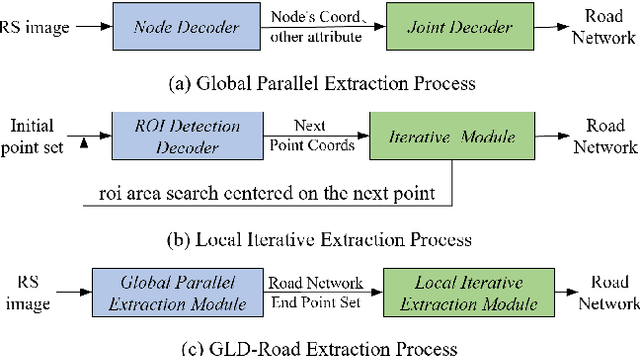
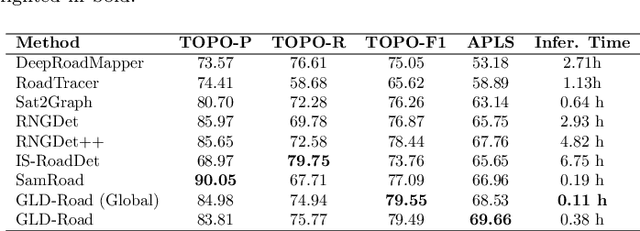
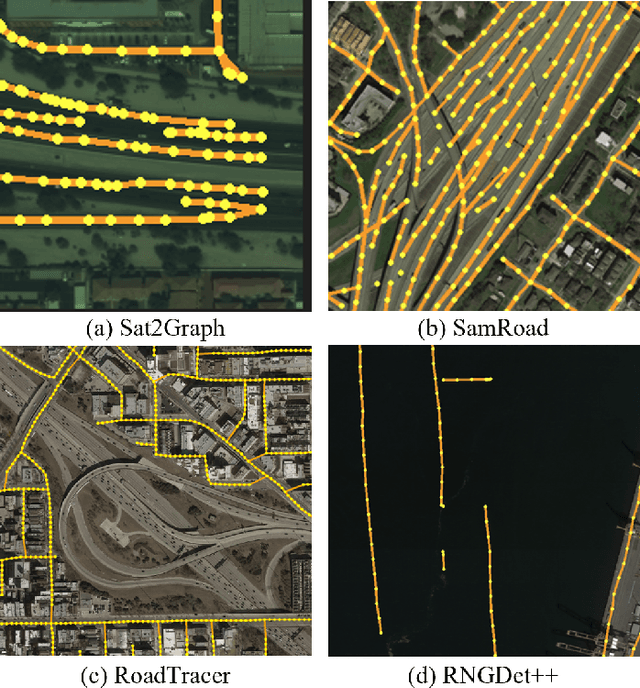
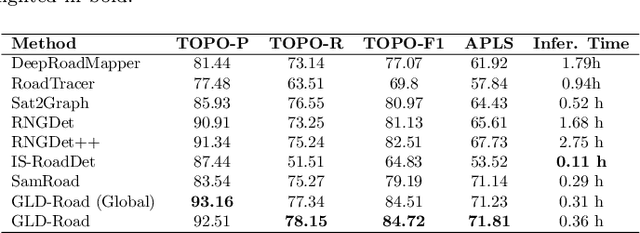
Abstract:Road networks are crucial for mapping, autonomous driving, and disaster response. While manual annotation is costly, deep learning offers efficient extraction. Current methods include postprocessing (prone to errors), global parallel (fast but misses nodes), and local iterative (accurate but slow). We propose GLD-Road, a two-stage model combining global efficiency and local precision. First, it detects road nodes and connects them via a Connect Module. Then, it iteratively refines broken roads using local searches, drastically reducing computation. Experiments show GLD-Road outperforms state-of-the-art methods, improving APLS by 1.9% (City-Scale) and 0.67% (SpaceNet3). It also reduces retrieval time by 40% vs. Sat2Graph (global) and 92% vs. RNGDet++ (local). The experimental results are available at https://github.com/ucas-dlg/GLD-Road.
ProxyThinker: Test-Time Guidance through Small Visual Reasoners
May 30, 2025Abstract:Recent advancements in reinforcement learning with verifiable rewards have pushed the boundaries of the visual reasoning capabilities in large vision-language models (LVLMs). However, training LVLMs with reinforcement fine-tuning (RFT) is computationally expensive, posing a significant challenge to scaling model size. In this work, we propose ProxyThinker, an inference-time technique that enables large models to inherit the visual reasoning capabilities from small, slow-thinking visual reasoners without any training. By subtracting the output distributions of base models from those of RFT reasoners, ProxyThinker modifies the decoding dynamics and successfully elicits the slow-thinking reasoning demonstrated by the emerged sophisticated behaviors such as self-verification and self-correction. ProxyThinker consistently boosts performance on challenging visual benchmarks on spatial, mathematical, and multi-disciplinary reasoning, enabling untuned base models to compete with the performance of their full-scale RFT counterparts. Furthermore, our implementation efficiently coordinates multiple language models with parallelism techniques and achieves up to 38 $\times$ faster inference compared to previous decoding-time methods, paving the way for the practical deployment of ProxyThinker. Code is available at https://github.com/MrZilinXiao/ProxyThinker.
Human in the Loop Adaptive Optimization for Improved Time Series Forecasting
May 21, 2025Abstract:Time series forecasting models often produce systematic, predictable errors even in critical domains such as energy, finance, and healthcare. We introduce a novel post training adaptive optimization framework that improves forecast accuracy without retraining or architectural changes. Our method automatically applies expressive transformations optimized via reinforcement learning, contextual bandits, or genetic algorithms to correct model outputs in a lightweight and model agnostic way. Theoretically, we prove that affine corrections always reduce the mean squared error; practically, we extend this idea with dynamic action based optimization. The framework also supports an optional human in the loop component: domain experts can guide corrections using natural language, which is parsed into actions by a language model. Across multiple benchmarks (e.g., electricity, weather, traffic), we observe consistent accuracy gains with minimal computational overhead. Our interactive demo shows the framework's real time usability. By combining automated post hoc refinement with interpretable and extensible mechanisms, our approach offers a powerful new direction for practical forecasting systems.
Do LLM Evaluators Prefer Themselves for a Reason?
Apr 04, 2025Abstract:Large language models (LLMs) are increasingly used as automatic evaluators in applications such as benchmarking, reward modeling, and self-refinement. Prior work highlights a potential self-preference bias where LLMs favor their own generated responses, a tendency often intensifying with model size and capability. This raises a critical question: Is self-preference detrimental, or does it simply reflect objectively superior outputs from more capable models? Disentangling these has been challenging due to the usage of subjective tasks in previous studies. To address this, we investigate self-preference using verifiable benchmarks (mathematical reasoning, factual knowledge, code generation) that allow objective ground-truth assessment. This enables us to distinguish harmful self-preference (favoring objectively worse responses) from legitimate self-preference (favoring genuinely superior ones). We conduct large-scale experiments under controlled evaluation conditions across diverse model families (e.g., Llama, Qwen, Gemma, Mistral, Phi, GPT, DeepSeek). Our findings reveal three key insights: (1) Better generators are better judges -- LLM evaluators' accuracy strongly correlates with their task performance, and much of the self-preference in capable models is legitimate. (2) Harmful self-preference persists, particularly when evaluator models perform poorly as generators on specific task instances. Stronger models exhibit more pronounced harmful bias when they err, though such incorrect generations are less frequent. (3) Inference-time scaling strategies, such as generating a long Chain-of-Thought before evaluation, effectively reduce the harmful self-preference. These results provide a more nuanced understanding of LLM-based evaluation and practical insights for improving its reliability.
LRSCLIP: A Vision-Language Foundation Model for Aligning Remote Sensing Image with Longer Text
Mar 25, 2025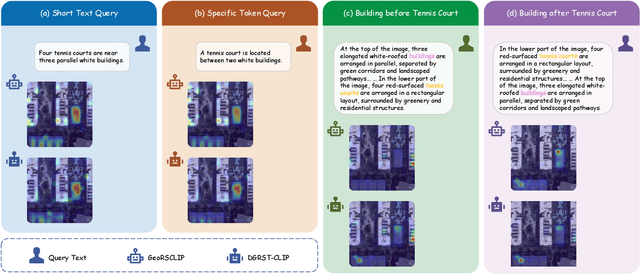
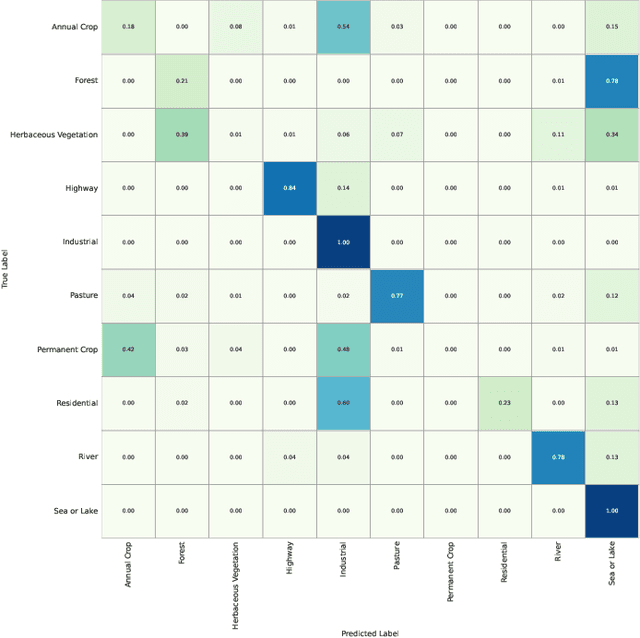
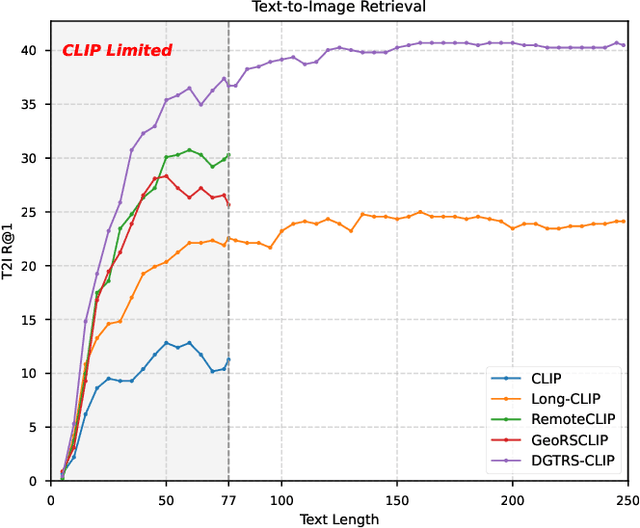
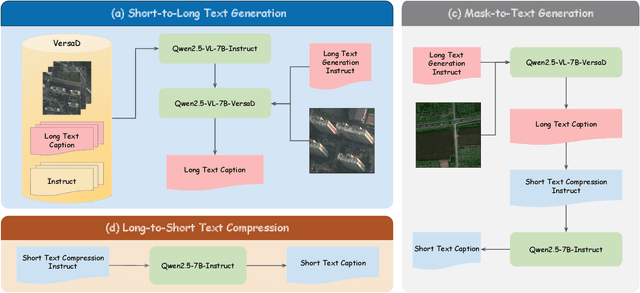
Abstract:This study addresses the technical bottlenecks in handling long text and the "hallucination" issue caused by insufficient short text information in remote sensing vision-language foundation models (VLFM). We propose a novel vision-language foundation model, LRSCLIP, and a multimodal dataset, LRS2M. The main contributions are as follows: (1) By integrating multi-source remote sensing data and adopting a large language model labeling strategy, we construct the LRS2M dataset, which contains 2 million image-text pairs, providing both short and long texts for the first time, thus solving the problem of semantic granularity limitations in existing datasets; (2) The design of the LRSCLIP architecture based on Long-CLIP's KPS module, which extends CLIP's text processing capacity and achieves fine-grained cross-modal feature alignment through a dual-text loss weighting mechanism. Experimental results show that LRSCLIP improves retrieval accuracy by 10\%-20\% over the Long-CLIP baseline in the zero-shot long-text cross-modal retrieval task. For the zero-shot short-text cross-modal retrieval task, LRSCLIP achieves improvements over the current best model, GeoRSCLIP, with increases of 0.17\%, 0.67\%, and 0.92\% in Text to Image R@1, Image to Text R@1, and mR on RSITMD, respectively, and 0.04\%, 2.93\%, and 1.28\% on RSICD. In the zero-shot image classification task (average accuracy=75.75\%) and semantic localization task (Rmi=0.7653), LRSCLIP achieves state-of-the-art performance. These results validate the dual advantages of fine-grained semantic understanding and global feature matching in LRSCLIP. This work provides a new benchmark model and data support for remote sensing multimodal learning. The related code has been open source and is available at https://github.com/MitsuiChen14/LRSCLIP.
PLPHP: Per-Layer Per-Head Vision Token Pruning for Efficient Large Vision-Language Models
Feb 20, 2025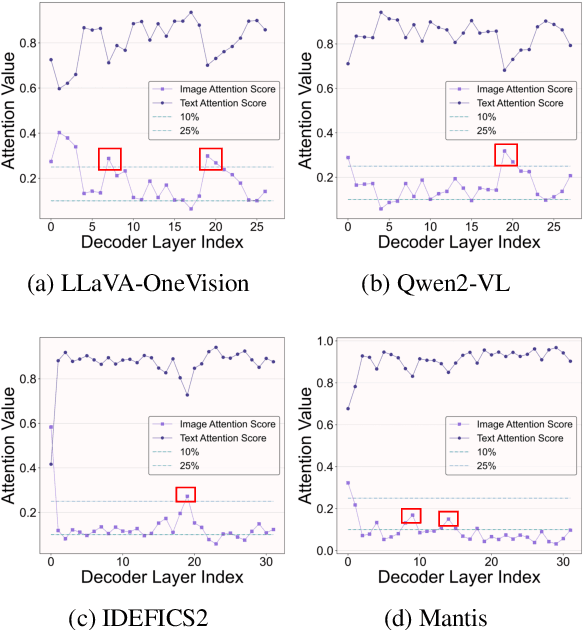
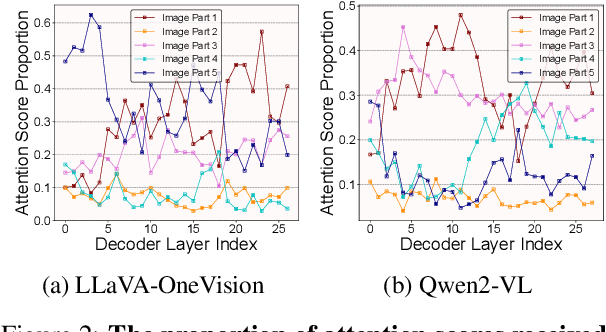

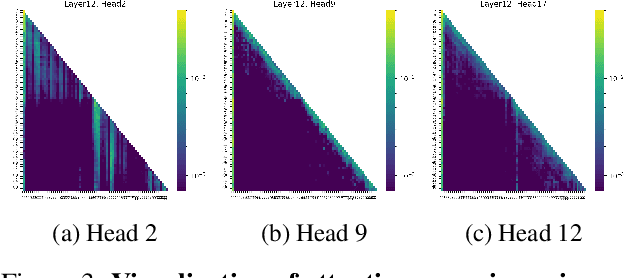
Abstract:Large Vision-Language Models (LVLMs) have demonstrated remarkable capabilities across a range of multimodal tasks. However, their inference efficiency is constrained by the large number of visual tokens processed during decoding. To address this challenge, we propose Per-Layer Per-Head Vision Token Pruning (PLPHP), a two-level fine-grained pruning method including Layer-Level Retention Rate Allocation and Head-Level Vision Token Pruning. Motivated by the Vision Token Re-attention phenomenon across decoder layers, we dynamically adjust token retention rates layer by layer. Layers that exhibit stronger attention to visual information preserve more vision tokens, while layers with lower vision attention are aggressively pruned. Furthermore, PLPHP applies pruning at the attention head level, enabling different heads within the same layer to independently retain critical context. Experiments on multiple benchmarks demonstrate that PLPHP delivers an 18% faster decoding speed and reduces the Key-Value Cache (KV Cache) size by over 50%, all at the cost of 0.46% average performance drop, while also achieving notable performance improvements in multi-image tasks. These results highlight the effectiveness of fine-grained token pruning and contribute to advancing the efficiency and scalability of LVLMs. Our source code will be made publicly available.
SayAnything: Audio-Driven Lip Synchronization with Conditional Video Diffusion
Feb 17, 2025
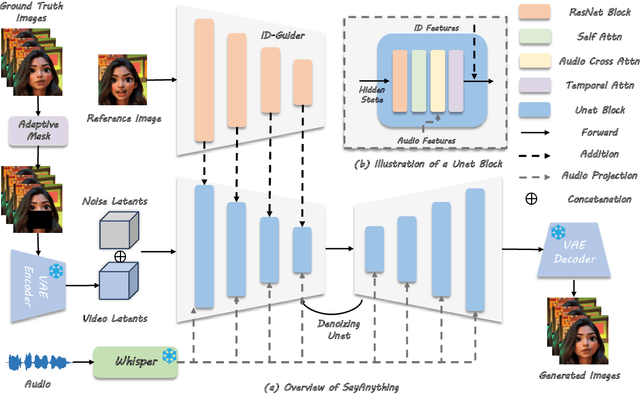


Abstract:Recent advances in diffusion models have led to significant progress in audio-driven lip synchronization. However, existing methods typically rely on constrained audio-visual alignment priors or multi-stage learning of intermediate representations to force lip motion synthesis. This leads to complex training pipelines and limited motion naturalness. In this paper, we present SayAnything, a conditional video diffusion framework that directly synthesizes lip movements from audio input while preserving speaker identity. Specifically, we propose three specialized modules including identity preservation module, audio guidance module, and editing control module. Our novel design effectively balances different condition signals in the latent space, enabling precise control over appearance, motion, and region-specific generation without requiring additional supervision signals or intermediate representations. Extensive experiments demonstrate that SayAnything generates highly realistic videos with improved lip-teeth coherence, enabling unseen characters to say anything, while effectively generalizing to animated characters.
LLM Alignment as Retriever Optimization: An Information Retrieval Perspective
Feb 06, 2025



Abstract:Large Language Models (LLMs) have revolutionized artificial intelligence with capabilities in reasoning, coding, and communication, driving innovation across industries. Their true potential depends on effective alignment to ensure correct, trustworthy and ethical behavior, addressing challenges like misinformation, hallucinations, bias and misuse. While existing Reinforcement Learning (RL)-based alignment methods are notoriously complex, direct optimization approaches offer a simpler alternative. In this work, we introduce a novel direct optimization approach for LLM alignment by drawing on established Information Retrieval (IR) principles. We present a systematic framework that bridges LLM alignment and IR methodologies, mapping LLM generation and reward models to IR's retriever-reranker paradigm. Building on this foundation, we propose LLM Alignment as Retriever Preference Optimization (LarPO), a new alignment method that enhances overall alignment quality. Extensive experiments validate LarPO's effectiveness with 38.9 % and 13.7 % averaged improvement on AlpacaEval2 and MixEval-Hard respectively. Our work opens new avenues for advancing LLM alignment by integrating IR foundations, offering a promising direction for future research.
 Add to Chrome
Add to Chrome Add to Firefox
Add to Firefox Add to Edge
Add to Edge